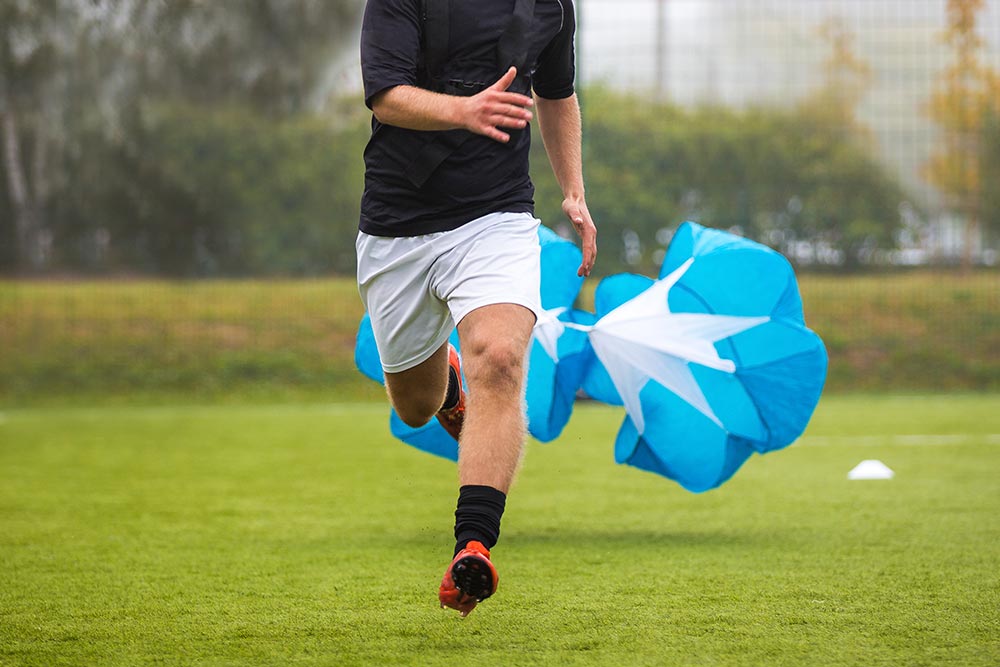Injured? Increase Your Muscle Mass with Blood Flow Restriction Training

Dayton Kelly
 It is not unusual in many gyms to see athletes, particularly weight lifters, with bands or wraps tied around their limbs whilst exercising. While it may appear strange, these athletes are intending to limit blood supply to their working muscle to spur muscle growth in a practice called “blood flow restrictive training”. While the additive effects of this practice to healthy individuals — capable of exercising at regular workloads — are debatable, the practice of exercising under blood restriction may have special relevance to those unable to bear heavy loads (Hughes, Paton, Rosenblatt, Gissane, & Patterson, 2017).
It is not unusual in many gyms to see athletes, particularly weight lifters, with bands or wraps tied around their limbs whilst exercising. While it may appear strange, these athletes are intending to limit blood supply to their working muscle to spur muscle growth in a practice called “blood flow restrictive training”. While the additive effects of this practice to healthy individuals — capable of exercising at regular workloads — are debatable, the practice of exercising under blood restriction may have special relevance to those unable to bear heavy loads (Hughes, Paton, Rosenblatt, Gissane, & Patterson, 2017).
That is, individuals such as those recovering from injury may be able to use blood flow restrictive training to maintain muscle mass after injury without compromising their health (Hughes, Paton, Rosenblatt, Gissane, & Patterson, 2017). This extends to postoperative patients, individuals with persistent back or lower limb injuries that inhibit heavy weight bearing, and elderly individuals uncomfortable with bearing heavy loads. While it has been previously accepted that such individuals will undergo muscle loss as a result of the inability to train at sufficiently heavy loads, blood flow restrictive training may allow growth at lower resistances allowing such individuals to not just maintain mass, but actually increase it during times of injury (Hughes, Paton, Rosenblatt, Gissane, & Patterson, 2017; Loenneke, Wilson, Marín, Zourdos, & Bemben, Low intensity blood flow restriction training: A meta-analysis, 2012).
Related Article: Is Quality Sleep a Predictor of Sports Injury?
High Or Low Resistance?
It has been previously thought that high resistance (≥70% of one repetition max) was a necessary requisite for inducing muscle growth; lighter loads were thought insufficient to induce enough metabolic stress and cellular damage to cause protein synthesis and muscle growth (Hughes, Paton, Rosenblatt, Gissane, & Patterson, 2017; ACSM, 2009). However, recent investigations have found lower resistances to allow for some muscular growth when sets are taken to failure (Hughes, Paton, Rosenblatt, Gissane, & Patterson, 2017; Ogasawara, Loenneke, Thiebaud, & Abe, 2013; Schoenfeld BJ, 2015). Subsequent investigations found coupling low resistance training to blood flow restriction exacerbated these adaptions such that they are comparable to higher resistance training (Hughes, Paton, Rosenblatt, Gissane, & Patterson, 2017). This augmentative effect of blood flow restriction has been hypothesized to result from the greater cellular stress by limiting oxygenation and waste removal from the working muscle (Hughes, Paton, Rosenblatt, Gissane, & Patterson, 2017).
Related Article: Does Low Blood Flow Restrict Resistance Training Load?
While this is a mechanism through which blood flow restrictive training may be facilitating muscle growth at lower weights is still debated, the actual benefits of this type of training have been repeatedly demonstrated (Hughes, Paton, Rosenblatt, Gissane, & Patterson, 2017). Analysis of published investigations found that low resistance (30% of one repetition maximum) blood flow restrictive training induces similar, but not superior, improvements in muscular strength to training at traditional resistances (≥70% of one repetition maximum; Hughes, Paton, Rosenblatt, Gissane, & Patterson, 2017 Loenneke, Wilson, Marín, Zourdos, & Bemben, Low intensity blood flow restriction training: A meta-analysis, 2012). Further, low resistance (30% of one repetition maximum) blood flow restrictive training seems to induce greater improvements in muscular size and strength than low resistance training alone (Loenneke, Wilson, Marín, Zourdos, & Bemben, Low-intensity blood flow restriction training: A meta-analysis, 2012).
Is There A Risk?
In terms of safety, blood flow restrictive training seems to pose no additive risk as compared to traditional resistance training with only minor side effects in some individuals including bruising and muscle soreness (Hughes, Paton, Rosenblatt, Gissane, & Patterson, 2017; Loenneke, Wilson, Wilson, Pujol, & Bemben, 2011). Though they likely require little concern for the average user, isolated cases of syncope (loss of consciousness) and rhabdomyolysis (rapid muscle loss) have been reported (Hughes, Paton, Rosenblatt, Gissane, & Patterson, 2017). While the optimal manner of blood restriction is still debated – the type of apparatus used, its tightness, and whether it should remain on continuously – it seems the use of a band or tourniquet imposing ~150 mmHg around the working limb during resistance training 2-3 days/week can exert beneficial effects (Loenneke, Wilson, Marín, Zourdos, & Bemben, Low-intensity blood flow restriction training: A meta-analysis, 2012).
The next time you are injured, it may be worth asking your doctor about blood flow restrictive training and how it can prevent you from losing your hard-earned muscle during recovery.
Related Article: Don’t Resist Resistance Training
You Might Like:
The Science of Temperature Therapy
Temperature therapy (also known as “thermal therapy” or “thermotherapy”) involves the use of heat or cold to improve health and function. Interestingly, thermotherapy has been around for centuries, with ancient cultures regularly using hot springs,...The Predictors of Longevity You Need to Care About
Living a long and healthy life is a universal aspiration, and with the publication of Peter Aittia’s new book “Outlive”, it has never been a bigger focus. With this has come the realisation that, while...How Overtraining and Undertraining Impacts Hormonal Health
While maintaining a healthy hormonal balance is essential for overall health and wellbeing, it is an often-overlooked component of women’s health. Hormones play a vital role in regulating various bodily functions, including metabolism, energy, mood,...12 days of Fitness: 12 Holiday workouts to crush this Christmas
The holiday period is a time for friends, food, and family. With this in mind, it should be a time of guilt-free fun. However, that doesn’t mean you have to neglect your fitness entirely over...Upper Body Strength in Post-Menopausal Women
Menopause is a unique time in the human life, and with it comes a myriad of changes that can have wide reaching health implications. However, over the last 20 years we have seen a strong...Exercise After Menopause: What You Need To Know
Menopause is one of the most significant events in a woman’s life, and with it comes several changes that can affect function. Moreover, the post-menopausal period comes with many health considerations that can have a...References
ACSM. (2009). American College of Sports Medicine position stand. Progression models in resistance training for healthy adults. Med Sci Sports Exerc, 41(3), 687–708. doi:10.1249/MSS.0b013e3181915670.
Hughes, L., Paton, B., Rosenblatt, B., Gissane, C., & Patterson, S. D. (2017). Blood flow restriction training in clinical musculoskeletal rehabilitation: A systematic review and meta-analysis. Br J Sports Med, 51(13), 1003-1011. doi:10.1136/bjsports-2016-097071.
Loenneke, J. P., Wilson, J. M., Marín, P. J., Zourdos, M. C., & Bemben, M. G. (2012). Low intensity blood flow restriction training: A meta-analysis. European journal of applied physiology, 112(5), 1849-1859. doi:10.1007/s00421-011-2167-x.
Loenneke, J. P., Wilson, J. M., Marín, P. J., Zourdos, M. C., & Bemben, M. G. (2012). Low intensity blood flow restriction training: A meta-analysis. European journal of applied physiology, 112(5), 1849-1859. doi:10.1007/s00421-011-2167-x.
Loenneke, J. P., Wilson, J. M., Wilson, G. J., Pujol, T. J., & Bemben, M. G. (2011). Potential safety issues with blood flow restriction training. Scand J Med Sci Sports, 21, 510–518. doi:10.1111/j.1600-0838.2010.01290.x .
Ogasawara, R., Loenneke, J. P., Thiebaud, R. S., & Abe, T. (2013). Low-load bench press training to fatigue results in muscle hypertrophy similar to high-load bench press training. International Journal of Clinical Medicine, 4(2), 114-121. doi:10.4236/ijcm.2013.42022.
Schoenfeld BJ, P. M. (2015). Effects of low-vs. high-load resistance training on muscle strength and hypertrophy in well-trained men. The Journal of Strength & Conditioning Research, 29(10), 2954-2963. doi:10.1519/JSC.0000000000000958.
















